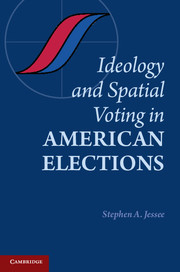Book contents
- Frontmatter
- Contents
- List of Figures
- List of Tables
- Preface
- 1 Introduction
- 2 Political Ideology
- 3 Measuring Political Ideology
- 4 Linking Theory and Empirics: Testing Spatial Voting Theory
- 5 Partisanship versus Proximity: The Effect of Party Identification on Spatial Voting
- 6 Political Information and Spatial Voting
- 7 The Political Perceptions of Citizens
- 8 Conclusion
- Appendix A Survey Question Wordings
- Appendix B Survey Sample Characteristics
- Appendix C Simplified Analyses of Ideology and Spatial Voting
- Appendix D American National Election Studies Analyses
- Bibliography
- Index
7 - The Political Perceptions of Citizens
Published online by Cambridge University Press: 05 August 2012
- Frontmatter
- Contents
- List of Figures
- List of Tables
- Preface
- 1 Introduction
- 2 Political Ideology
- 3 Measuring Political Ideology
- 4 Linking Theory and Empirics: Testing Spatial Voting Theory
- 5 Partisanship versus Proximity: The Effect of Party Identification on Spatial Voting
- 6 Political Information and Spatial Voting
- 7 The Political Perceptions of Citizens
- 8 Conclusion
- Appendix A Survey Question Wordings
- Appendix B Survey Sample Characteristics
- Appendix C Simplified Analyses of Ideology and Spatial Voting
- Appendix D American National Election Studies Analyses
- Bibliography
- Index
Summary
If we are to understand what leads the voter to his decision at the polls we must know how he sees the things to which this decision relates.
(Campbell, Converse, Miller, and Stokes 1960, 42)Political scientists are quite fond of bemoaning the levels of political knowledge and political competence of the American public. In fact, this general strain of pessimism is among the most common reasons that many scholars are skeptical of the spatial approach as a useful framework within which to analyze the decisions of voters. Spatial models typically assume that voters base their decisions on their relative ideological proximity to the candidates in a given election, which would seemingly require that a reasonably accurate perception of the positions of each candidate is held by most voters. This chapter is principally concerned with the question of how well ordinary citizens understand the true ideological stances of the candidates in presidential elections. In other words, do voters possess the tools to cast their votes based on which candidate is closest to them?
The answers to these questions that are offered by the classic works in American political behavior (e.g., Campbell et al. 1960; Converse 1964; Kinder and Sears 1985; Zaller 1992) are not encouraging in terms of their suggestions about citizen attention, knowledge, or competence. How, then, can the findings of the previous chapters, which reveal an electorate that is able to cast reasonably accurate votes according to the spatial standard based on candidate positions, be reconciled with these earlier findings? This chapter examines citizen perceptions of candidate ideology using an extension of the survey and statistical methods employed in previous chapters.
- Type
- Chapter
- Information
- Ideology and Spatial Voting in American Elections , pp. 155 - 172Publisher: Cambridge University PressPrint publication year: 2012



